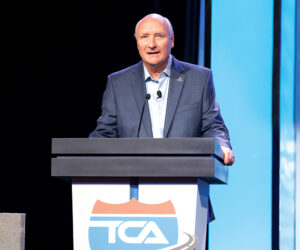ARLINGTON, Va. — Traffic congestion on the U.S. National Highway System added nearly $74.5 billion in operational costs to the trucking industry in 2016, a 0.5 percent increase over 2015, according to research released Thursday by the American Transportation Research Institute.
In its latest “Cost of Congestion” analysis, ATRI utilized a variety of data sources, including its unique truck GPS database to calculate delays on just the NHS totaling nearly 1.2 billion hours of lost productivity.
This equates to 425,533 commercial truck drivers sitting idle for a working year.
The analysis showed the average congestion cost per truck in 2016 was $6,478 as compared with $6,616 in 2015.
Using the Federal Highway Administration’s total truck vehicle miles traveled, cost-per-mile for 2016 was the same as 2015 — $0.26 — but the total VMT in 2016 was 287,894,900 versus 279,843,600 in 2015, an increase of 2.9 percent.
It is no doubt worse — a lot worse — for on-highway trucks, even though the analysis doesn’t break down on-highway tractors separately, but rather breaks down trucks by vehicle miles traveled.
The analysis is based on 11.5 million large trucks in the United States. Only 2.6 million of those are Class 8 truck tractors.
“Unfortunately, the truck volume data underlying this analysis do not allow us to break out congestion costs by vehicle class,” Alan Hooper, ATRI research associate, said. “However, Class 7 and 8 vehicles are heavily represented in these data, so the results of our analysis are definitely relevant to operators of these vehicles.”
That analysis shows the average congestion cost for trucks driven 100,000 miles was just over $25,000; for 125,000 miles is was just over $32,000; and for trucks driven 150,000 it was almost $40,000.
Hooper listed three takeaways/surprises in the analysis:
- Congestion costs increased between 2015 and 2016 despite the soft freight market that year, the effects of which can be seen in the year-over-year decline in congestion costs observed during the second half of 2016.
- The congestion costs incurred by the trucking industry are increasingly concentrated in a relatively small number of densely populated urban areas. The top 10 states in terms of congestion costs combine to account for over half (51.8 percent) of these costs, while the top 10 metropolitan areas represent one-quarter of the national total. Moreover, over 90 percent of congestion costs occur in urban metropolitan areas. Another way to look at it is that 85.7 percent of the industry’s congestion costs occur on just 17.2 percent of NHS miles.
- The effects of temporary delays (e.g. construction or weather-related delays) will be more pronounced in areas with relatively small roadway networks. For instance, the Elizabethtown/Fort Knox, Kentucky, metropolitan area tops the list in terms of both congestion costs per mile and per-mile increases because of the I-65 widening project. Similarly, congestion costs surged in Lafayette, Louisiana, in part because of the effects of the catastrophic flooding that impacted much of southern Louisiana in August 2016.
As expected, the survey showed traffic congestion tended to be most severe in urban areas, with more than 91 percent of the total congestion costs generating from metropolitan areas.
ATRI’s analysis also documented the states, metropolitan areas and counties that were most impacted by these delays and subsequent cost increases.
The top 10 states experienced costs of more than $2.4 billion each, led by Texas and Florida with over $5.5 billion each. Others in the top 10 included California, New York, New Jersey, Illinois,
Pennsylvania, Tennessee, Ohio and North Carolina. The top 10 states combined account for 51.8 percent of the congestion costs nationwide.
The top 10 states with the largest increase in cost congestion were Texas, California, Wisconsin,
West Virginia, Louisiana, Mississippi, Georgia, Hawaii, Florida and Rhode Island
“Perhaps no other issue has as great an impact on this nation’s supply chain as traffic congestion. In the face of growing and pervasive congestion, not only does the trucking industry lose billions annually but ultimately the consumer pays the price through higher prices on the shelf,” said Benjamin J. McLean, Ruan Transportation Management Systems CEO and a member of the ATRI board of directors. “Doing nothing to address the state of our nation’s infrastructure will create a significant impediment to the growth of our economy.”
As part of this analysis, ATRI has updated its congestion cost database with 2016 data to provide granular cost information to transportation planning officials on the hours of delay and associated cost by major jurisdiction type and road level.
ATRI listed three major factors that contributed to increased congestion in 2016:
- A continued increase in traffic incidents, including a record 7.3 million police-reported crashes and a 5.6 percent increase in fatalities from motor vehicle crashes on U.S. roadways.
- Growing economic activity as evidenced by annual U.S. Gross Domestic Product growth of 1.5 percent and growth in e-commerce sales of 14.9 percent between 2015 and 2016, and
• Weather impacts such as Winter Storm Jonas — a record-breaking snowstorm which impacted the Northeast, Appalachians, and mid-Atlantic in January 2016.
Lyndon Finney’s publishing career spans over 55 years beginning with a reporter position with the Southwest Times Record in Fort Smith, Arkansas, in 1965. Since then he’s been a newspaper editor at the Southwest Times Record, served five years as assistant managing editor of the Arkansas Democrat-Gazette in Little Rock and from November 2004 through December 2019 served as editor of The Trucker. Between newspaper jobs he spent 14 years as director of communications at Baptist Health, Arkansas’ largest healthcare system. In addition to his publishing career he served for 46 years as organist at Little Rock’s largest Baptist church.







